
Overview
Performance and driver enjoyment can often be viewed as conflicting elements to good fuel economy and low emission levels. The challenge of the CR-Z powertrain development team was to overcome this traditional trade-off between performance and the environment by developing an approach that could satisfy a new era of environmentally conscious enthusiast drivers. As the first sport hybrid coupe introduced for retail sale in North America, the all-new CR-Z is intended to demonstrate how green technology can also be fun and sporty.
Powertrain Highlights
- 1.5-liter SOHC 16-valve i-VTEC 4-cylinder engine with Integrated Motor Assist (IMA)
- High-power, lightweight, ultra-thin hybrid electric motor
- Lightweight, compact and durable Intelligent Power Unit (IPU)
- New 3-mode drive system with Sport, Normal and Econ modes
- Six-speed manual transmission (first ever for a hybrid) or available CVT
Now in its sixth unique version since debuting on the original 2000 Insight, the compact and simple-in-concept Integrated Motor Assist (IMA) system is a parallel hybrid powertrain that increases efficiency through the electric motor's power assist, energy regeneration and idle-stop capabilities. The CR-Z's 1.5-liter, 4-cylinder, 16-valve i-VTEC gasoline engine serves as the primary power source and is designed to provide driver enjoyment with its responsive performance, a broad torque band and enthusiastic engine note. A 10-kilowatt, ultra-thin electric motor works in tandem with the gasoline engine to provide additional power and electricity generation as needed. Electricity is stored and delivered through a lightweight and compact 100.8-volt battery and power control system.
The hybrid-electric motor's broad torque band with instantaneous torque at low RPM is designed to complement the CR-Z's standard six-speed manual transmission particularly well in city driving. The broad torque band contributes to sporty acceleration and reducing the need to shift as frequently in order to stay within the engine's power band (compared to conventional gasoline-engine vehicles).
A Continuously Variable Transmission (CVT) is available and offers elevated levels of fuel economy. A driver-selectable 3-mode drive system allows the vehicle to be operated in Sport, Normal or Econ mode to help maximize either performance or economy. Sport mode enhances the power delivery curve from the IMA system. Eco Assist and Eco Score are provided as driver efficiency tracking tools with real-time and cumulative feedback to economical driving styles.

Combined, the gasoline engine and electric motor produce a peak output of 122 horsepower at 6,000 RPM and 128 lb-ft. of torque at 1,000 to 1,750 RPM on manual transmission models (123 lbft at 1,000 to 2,000 on CVT-equipped models). Individually, the gasoline engine produces 113 horsepower (84 kW) @ 6,000 RPM and 107 lb-ft. (144 Newton meters) of torque at 4,800 RPM. The electric motor can add a maximum of 13 horsepower (10 kW) @1,500 RPM and 58 lb-ft. of torque at 1,000 RPM. The peak outputs for the gasoline engine and the electric motor occur at different RPM ranges, resulting in a broad power curve and a wider range of performance than a similar-sized, conventional gasoline-powered vehicle or an electric-only vehicle.
Background: Measurement of Combined Horsepower and Torque in Hybrid Powertrains Since the peak output for the CR-Z's gasoline engine and electric motor occur at significantly different RPM ranges, the combined rating for horsepower and the combined rating for torque represent the operational capability measured at the output shaft when the two systems are functioning together as a single system. Therefore, combined power ratings for Honda hybrid vehicles represent peak power delivery in real-world operating conditions and take into account the unique RPM when each peak occurs. The combined power numbers do not represent the simple addition of the peak numbers for the gasoline engine and electric motor. This calculation method is why 112 horsepower (gasoline engine) plus 13 horsepower (electric motor) equals a combined output of 122 horsepower (not 125 horsepower combined).
1.5-Liter 16-valve SOHC i-VTEC 4-Cylinder Engine
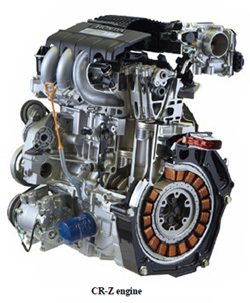
The CR-Z's 1.5-liter i-VTEC all-aluminum engine offers a balance between high fuel economy and funto- drive performance. The engine displaces 1,497 cc and has a 10.4:1 compression ratio. The underbore design has a bore and stroke measuring 73 mm x 89 mm, respectively. The compact i- VTEC cylinder head utilizes a narrow, 30- degree design between the intake and exhaust valves, contributing to the engine's overall compact size. Friction-reducing technologies include roller-bearing tipped rocker arms, a low-friction timing chain tensioner, molybdenum-coated piston skirts and an offset crankshaft and connecting rod design.
i-VTEC Valvetrain
Part of the balance between efficiency and power is made possible by Honda's i- VTEC variable valve timing system. In the CR-Z's 16-valve SOHC engine, the i- VTEC system employs a two-rocker arm design (per cylinder on the intake valves) with friction-reducing roller followers for each pair of intake valves, along with intake cam lobes configured to optimize both low- and highspeed operation. A chain drive connects the crankshaft to the camshaft. Depending on engine load and RPM, an electronic controller determines which cam profile will be used and exactly how the intake valves will operate.
At low RPM, where low lift and shorter duration provide optimal operation, the timing of the two intake valves is staggered and the lift asymmetrically skewed in favor of the primary valve. This helps to create a swirl effect within the combustion chamber that increases the efficiency of the burn process. Above approximately 2,300 RPM, a hydraulically actuated spool valve causes a locking pin to engage the secondary rocker arm with the primary one, transitioning the secondary valve into a long-duration mode that increases the volume of air/fuel mixture moving into the combustion chamber. The additional air/fuel mixture helps increase power at high RPM.
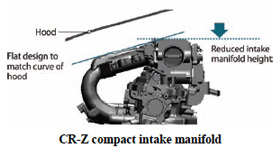
Compact Intake Manifold
The lightweight and compact composite intake manifold provides sufficient clearance for the CRZ's low hood while still maintaining enough clearance for Honda's internal standards for pedestrian protection.
Electronic Drive-by-Wire Throttle Control
Continuously optimizing the ratio of movement between the throttle pedal and the throttle butterfly valve in the intake manifold, Drive-by-Wire optimizes engine response and IMA operation to match driving conditions and driver expectations for throttle input. The system uses a highly responsive DC motor to change the throttle position quickly and precisely.
Programmed Fuel Injection (PGM-FI)
The Programmed Fuel Injection (PGM-FI) is a lightweight, compact system that ensures optimal air-fuel ratio by monitoring throttle position, engine temperature, intake-manifold pressure, intake-air mass flow, atmospheric pressure, exhaust-gas oxygen content and intake-air temperature to control fuel delivery via four multi-holed injectors mounted in the intake port of the cylinder head.
Direct Ignition System with Dual-Probe Spark Plugs
The CR-Z has a direct ignition system with a coil unit for each cylinder, positioned within each spark plug's access bore. The CR-Z uses dual-probe spark plugs for faster mixture ignition speed and improved combustion stability. With the spark arcing just beyond the relatively large surface of the ground area, the air/fuel mixture is exposed to a larger portion of the spark, which enhances stable combustion.
Maintenance Minder System and Tune-Up Intervals
The Maintenance Minder™ system calculates the engine's tune-up schedule based on driving conditions tracked by the Powertrain Control Module. When determining proper maintenance intervals, the system minimizes owner guesswork about whether the vehicle is being operated in standard or severe conditions. The Maintenance Minder information appears in the Multi- Information Display, and indicates when to change the oil, oil filter (every other oil change), air cleaner, transmission fluid, spark plugs and coolant, as well as when to rotate the tires. A tune-up is not required until 100K+/- Miles No Scheduled Tune-ups*.
*May vary with driving conditions. Does not apply to fluid and filter changes. Exact mileage is determined by actual driving conditions. The owner's manual contains full detail.
Noise, Vibration and Harshness Reduction
A subframe torque rod damper system reduces engine rocking and helps to isolate powertrain noise and vibration from the passenger compartment. Hydraulic engine mounts and reinforcements in the engine compartment help to further reduce engine noise and vibration for a more comfortable ride.
Sport-Tuned Exhaust System
The CR-Z's exhaust system has been designed to express a sporty performance character note that increases smoothly and proportionally with increasing engine speed. Typically, the exhaust note of a performance-oriented car sounds most impressive in the mid-range audio frequencies. Mid-frequencies are often perceived as desirable compared to low frequencies or high frequencies that can convey undesirable noise - like drumming noise or road noise during idling or cruising conditions. The CR-Z's exhaust system achieves its sporty sound by closely coordinating the exhaust frequency orders produced by the muffler with the vehicle body's resonate properties.
This approach prevents certain, undesirable sounds from entering the cabin while desirable sounds are allowed inside. Contributing to the sporty note, the layout of the resonator chambers inside the muffler is divided into several expansion chambers by separator walls connected by pipes, which have small holes that allow exhaust gas to flow through. When gas flows through these expansion chambers it emits sound exclusive to the length and diameter of the pipes.
From idle to 3000 RPM, where the CR-Z would typically operate under normal driving, the vehicle expresses a distinct-yet-subtle exhaust note that suggests power. The sound of second order booming noise at low engine speed is reduced, which leaves the most-desirable aspects of the engine note, the 4th order exhaust sound, as the most-prominent vehicle operation sound inside the cabin. At higher RPM, the exhaust note has been tuned to coordinate with the frequencies inherent to the vehicle's body. Unwanted resonance frequencies have been minimized by calibrating the noise-insulating properties of the engine mounts and by using conventional insulation material throughout the vehicle.
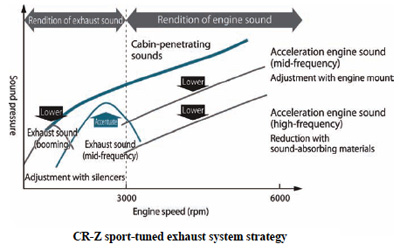
Additional measures have been taken to tune the exhaust note specifically for manual-transmission models and the CVT models due to the different gearing principles, and subsequently unique engine speeds at a given velocity. The manual transmission and the CVT each have unique expansion chamber layouts that have been optimized to achieve a good sound for both versions.
Fuel Economy and Emissions
EPA-estimated fuel economy is rated at 35/39/37 city/highway/combined miles per gallon3 on CVT-equipped models. Manual transmission models are EPA-rated at 31/37/34 city/highway/combined miles per gallon3. The CR-Z is rated as an Advanced Technology Partial Zero Emissions Vehicle (AT-PZEV) in states that adhere to California Air Resource Board (CARB) ZEV standards (EPA Tier 2, Bin 2 in all states). Low emissions are a key trait of every Honda engine, and the CR-Z employs an oblique flow catalytic converter (increases contact area of exhaust gas inside catalyst), stainless steel exhaust pipes (fast warm up, good heat dissipation and low weight) and a conventional exhaust gas recirculation system (re-routes part of the exhaust gas back into the intake air fuel mixture). To keep operating costs at a minimum, the CR-Z is designed to use regular unleaded fuel.
Integrated Motor Assist (IMA) Overview
As with previous versions, the IMA system consists of an ultra-thin DC brushless electric motor mounted between the gasoline engine and the transmission, and an Intelligent Power Unit (IPU) that stores electric power in a compact battery box and controls the flow of electricity to and from the electric motor.
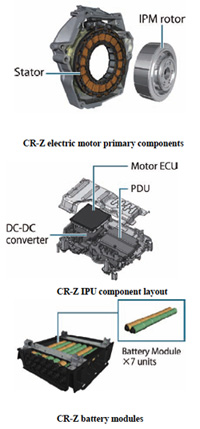
10 kW DC Brushless Electric Motor
The ultra-thin DC brushless electric motor contributes up to 13 hp (10 kilowatts) @ 1,500 RPM and 58 lb-ft. of torque @ 1,000 RPM to the CR-Z gasoline engine output, assisting primarily in acceleration and some steady-state cruising situations. The motor also acts as a generator during braking, some steady-state cruising, gentle deceleration and coasting to capture kinetic energy and recharge the battery. The ultra-compact electric motor, measuring 61 mm in case width, is located between the engine and transmission (clutch on manual transmission models), and is an AC synchronous three-phase electric motor.
Intelligent Power Unit (IPU) with Nickel Metal Hydride Battery Pack
The Intelligent Power Unit (IPU) controls the power of the IMA system. The IPU contains the energy storage module (battery), Power Control Unit (PCU), motor Electric Control Unit (ECU), and a compact air-flow cooling system. The IPU is located beneath the rear cargo area for minimal impact on interior space. The nickel metal hydride (Ni-MH) battery system consists of seven modules that send power to the electric motor as it assists the engine. It also stores the electricity when the motor generates electricity during regenerative braking. The seven-module battery system is comprised of 84 individual "D-sized" 1.2-volt cells for a total battery system output of 100.8 volts and a capacity of 5.75 ampere-hours.
IMA System Operation
The CR-Z's regenerative braking system apportions braking power in a linear fashion between the hydraulic brakes and the electric motor, allowing the IMA system to extract electricity from the vehicle's kinetic energy at a pre-set rate. During braking, a braking pressure sensor sends a signal to the IPU, which engages the regenerative braking via the electric motor performing as a generator. The linear aspect of the braking system results in a firm, direct feel consistent with a sporty car.

Automatic Idle Stop
The CR-Z automatically turns off the gasoline engine during complete stops under normal operating conditions. This feature allows the vehicle to use even less fuel and emit fewer emissions than a conventional automobile. The system uses the IMA electric motor to restart the engine. When the air conditioner is in use, selecting Econ mode can increase the potential for the idle-stop feature to keep the engine deactivated for a longer duration of time under certain conditions.
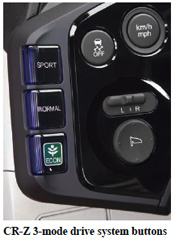
3-Mode Drive System
The CR-Z's 3-mode drive system allows the driver to select between individual modes of performance for Sport, Normal and Economy driving styles. The system is activated via three backlit buttons to the left of the steering wheel.
Sport Mode
The Sport mode enhances multiple vehicle systems for performance including the engine throttle responsiveness, electric power steering effort, the electric motor power assist and CVT (available) gear ratio. The inner ring of the tachometer illuminates red when the vehicle is in Sport mode.
Pushing the Sport Mode button influences the following systems (compared to Normal Mode):
- Additional IMA electrical power available during acceleration (exclusive to 6MT model)
- Steering assist becomes firmer and more direct
- DBW throttle angle optimized for enhanced acceleration feel
- CVT (if equipped) transmission ratios are optimized lower to maintain higher engine RPM and quicker acceleration
- A/C operates normally
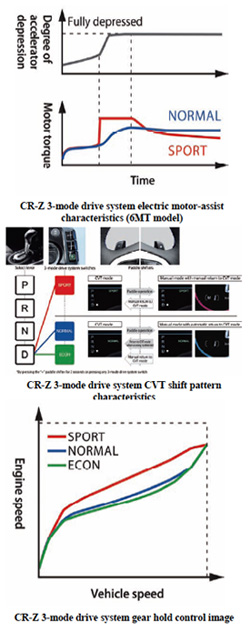
Normal Mode
Normal mode provides standard settings for steering, engine response, motor assist and air conditioning. Similar to Econ mode, the tachometer ring transitions between blue and green when the vehicle is in normal mode, with the green representing more efficient driving. At startup the vehicle will default to Normal mode if the vehicle was previously driven in Sport mode.
- Steering assist is normal
- DBW throttle angle optimized for linear acceleration feel
- CVT (if equipped) transmission ratios are optimized for greater economy
- A/C operates normally
Econ Mode
During Econ mode operation, the engine's responsiveness is tuned for optimal economy, the electric motor assist gives priority to fuel efficiency and the air conditioning system can reduce its overall load on the engine.
Pushing the Econ button initiates a range of functions that increase the fuel economy of the CR-Z's Integrated Motor Assist (IMA) system:
- DBW throttle angle optimized for smoother acceleration and maintains lowest possible engine RPM
- Reduces automatic climate control blower fan speed and minimizes A/C compressor engagement whenever possible
- CVT (if equipped) transmission ratios are optimized higher (relative to engine RPM) for greater economy
- Limits power and torque by approximately 4 percent (full responsiveness is provided at wide-open-throttle)
- Cruise control uses a smaller throttle opening angle whenever possible
- Steering assist is normal
Ecological Drive Assist (Eco Assist)
The Ecological Drive Assist System (Eco Assist™) is a fuel economy information system designed to help the driver develop and maintain a fuel-efficient driving style. The system monitors driving style, and can display the impact of a driving style on the vehicle's fuel economy. The system also provides feedback that can help the driver make adjustments to driving style. The system guides drivers in accelerating and braking in ways that consume less fuel, and in taking better advantage of regenerative braking. Using these tools, the driver can achieve improved fuel economy performance.
The feedback provided by Eco Assist simply and effectively helps drivers accelerate and brake in ways conducive to enhanced fuel economy. Fuel-saving activities like smooth acceleration and braking make the inner ring glow green. Somewhat less-efficient driving makes the meter glow blue-green. Aggressive starts and stops that consume extra fuel make the meter glow blue. By observing the inner ring's response to driving practices and seeking to achieve a consistently green color, drivers can receive assistance in developing driving habits that typically enhance fuel economy.
Maintenance Minder
The Maintenance Minder™ system calculates the engine's tune-up schedule based on driving conditions (tracked by the PCM). When determining proper maintenance intervals, the system minimizes owner guesswork about whether the vehicle is being operated in standard or severe conditions. The CR-Z's Maintenance Minder system information appears in the Multi- Information Display (MID) and indicates when to change the oil, oil filter (every other oil change), air cleaner, transmission fluid, spark plugs, engine coolant, as well as when to rotate the tires. A tune-up is not required until about 100,000 miles. (Note: 100K+/- Miles No Scheduled Tune-ups may vary with driving conditions. Does not apply to fluid and filter changes. Exact mileage is determined by actual driving conditions. The owner's manual contains full details.) Long-life fluids have been used for reduced environmental impact (fluid disposal) and reduced maintenance costs. As a result, engine coolant changes are needed about every 10 years or approximately 100,000 miles, and engine oil changes are required around 7,500 miles under normal driving conditions, or annually if fewer miles are driven per year.
Transmissions Overview
| CR-Z Gear Ratios | ||
| 6-Speed MT | CVT | |
| 1st (CVT Max) | 3.143 | 3.173 |
| 2nd | 1.870 | - |
| 3rd | 1.303 | - |
| 4th | 1.054 | - |
| 5th | 0.854 | - |
| 6th(CVT Min.) | 0.689 | 0.529 |
| Reverse | 3.307 | 5.666 - 2.167 |
| Final Drive Ratio | 4.11 | 4.20 |
Two transmissions are offered with the CR-Z, a standard six-speed manual and a continuously variable automatic transmission. Both are designed to optimize the power transfer from CR-Z's low-end torque and allow for smooth acceleration.
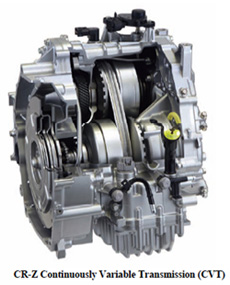
Continuously Variable Transmission (CVT)
The available automatic Continuously Variable Transmission (CVT) offers smooth and predictable transitions and excellent low-end acceleration and low-RPM cruising. By helping the engine and IMA motor stay in their most efficient operating range, the CVT provides an operating efficiency benefit superior to that of a conventional 5-speed automatic transmission and it allows for greater efficiency during regenerative braking by smoothing deceleration. The use of a low gear ratio results in quick-reacting initial acceleration performance. The start clutch control is designed to take full advantage of the features of the IMA system, engaging at low RPM to enhance initial acceleration and contribute to fuel efficiency.
The shift lever has four positions; P: PARK, R: REVERSE, N: NEUTRAL, and D: DRIVE. An additional Sport mode is available and can be activated via a button to the left of the steering wheel. Sport mode activates unique programming for the paddle shifters and provides a 1st through 7th speed ratios. When the engine's redline is reached while in manual mode, the CR-Z will automatically shift to the next gear ratio. It will also shift down to an appropriate lower gear ratio if necessary.
The CVT is an electronically controlled automatic transmission with the drive and driven pulleys, and a steel belt. It provides "stepless" forward speeds and one in reverse. Each pulley consists of a movable face and a fixed face, and the effective pulley ratio changes with engine speed. The drive pulley and the driven pulley are linked by the steel belt.
To achieve a low pulley ratio, high hydraulic pressure works on the movable face of the driven pulley and reduces the effective diameter of the drive pulley, and a lower hydraulic pressure works on the movable face of the drive pulley to eliminate the potential for steel belt slippage.
To achieve a high pulley ratio, high hydraulic pressure works on the movable face of the drive pulley and reduces the effective diameter of the driven pulley, and low hydraulic pressure works on the movable face of the driven pulley to eliminate the potential for steel belt slippage.
Six-Speed Manual Transmission
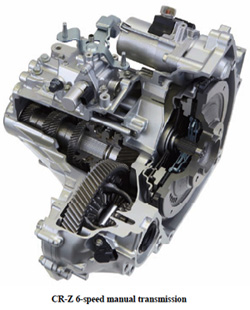
A manual gearbox was essential and Honda engineers determined that a 6- speed was the optimum gearbox for both fuel economy and sporty driving. As a parallel hybrid system it is relatively easy to adapt Honda's IMA system to work with a variety of hardware, and as demonstrated by the 2000 Insight, a manual gearbox can work well with the right hybrid technology. The manual gearbox gives the CR-Z a very different character from existing hybrid models. The gearbox has been developed with the enthusiastic driver in mind, with a short shift throw (45 mm) and a firm but light action that encourages the driver to change gears regularly. Tolerances of the shift mechanism components have been optimized to reduce free play in the mechanism. The detent is a component that controls the movement of the shift lever and this area was the subject of a great deal of attention to achieve a positive click with each gear change. Even with a six-speed gearbox and sporty shift action, it is not essential to continuously work the CR-Z's gearbox. The ample low-end torque of the engine and IMA system means in-gear flexibility is also impressive.
(See interior section for shift lever ergonomics.)
A Shift Indicator Light (SIL) system uses arrows on the instrument panel meter cluster that suggests to the driver when to shift up or down for efficient driving. The system is designed to help the driver control the engine speed in a range where it has best efficiency for each driving situation. The SIL also interacts with the Eco Assist ambient meter around the tachometer. When fuel economy decreases, the SIL gives an indication to shift gears and the ambient meter transitions from green to the intermediate blue-green color.
If the gear change is carried out within an appropriate time, then the ambient meter will change back to green. If the gear change does not occur, then the ambient meter will change to blue. The driver can follow the guidance of the ambient meter or the SIL to achieve optimal fuel economy.
To provide driving enthusiasts with exceptional control and feel, the six-speed manual transmission's 4.11 final-drive gear ratio maximizes the engine's torque for quicker acceleration. By employing large-capacity synchronizers (double brass cone on 2nd gear; and a single carbon cone on 3rd gear), the six-speed manual transmission offers an exceptionally light shift effort for the driver. Further refining the transmission's sporty, high-quality feel is a short-stroke clutch pedal for quicker shifting, a hydraulic damper integrated with the clutch master cylinder for reduced clutch vibration, and an innovative clutch-friction material for improved clutch engagement feel.